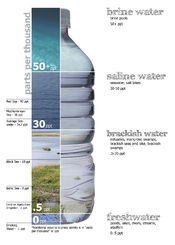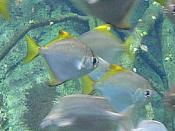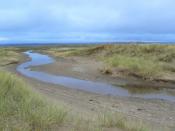Brackish water is a fairly salty mixture of freshwater and sea water. It is
unique in numerous ways and is a life giving ecosystem. To understand what
brackish water is, a background should be known about its sources.
First of all, there is freshwater. Out of all the water on the planet, only three
percent of it is fresh, and only one fiftieth of one percent is readily available.
Freshwater is not pure in that it contains minerals and other particles. There are
numerous plants and animals that depend on freshwater for their lives. Humans are
one of them. Seventy percent of the human body is made up of freshwater (744
Headlam).
Next, there is saltwater, or seawater. Seawater consists of fifty-five percent
chlorine, and thirty-one percent sodium (Groliers). It makes up approximately
ninety-seven and two tenths percent of the total volume of the world's water, and
covers more than seventy percent of the earth's surface (Groliers).
Sea water
doesn't just contain hydrogen, oxygen, sodium, and chlorine; it also contains every
naturally occurring element. Although seawater has a fairly constant ratio of major
elements, salinity and seawater can fluctuate. Normally, the salinity is thirty-four to
thirty-seven parts per thousand (ppt.), but on a particularly rainy morning, the salinity
may decrease to something as low as thirty-two ppt. (Stuller 29).
The mixing of freshwater and sea water forms a third type of water, known as
brackish water. Brackish water can be found in a variety of mixing zones such as
river deltas, freshwater title marshes, estuaries, fjords, and in the middle of the
ocean
(Stuller 30). To begin with, freshwater traveling towards the sea carries suspended
particles. As the particles make contact with saltwater, an electrochemical reaction
called flocculation takes place. The clay with a positive charge, and the sodium...


